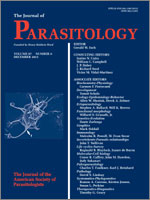The slate sweetlips, Diagramma labiosum Macleay, 1883 (Perciformes: Haemulidae), off Heron Island, Great Barrier Reef, Queensland, Australia, hosts 2 new species of Benedenia Diesing, 1858 (Monogenea: Monopisthocotylea: Capsalidae). Benedenia beverleyburtonae n. sp. infects proximal regions of the primary gill lamellae and gill arches. The adult is characterized by a dorsal vaginal pore anterior to the common genital pore and a voluminous, highly coiled vas deferens. This species also has fine muscle fibrils concentrically arranged in the haptor. Its ciliated oncomiracidium differs little from larvae of other Benedenia species, with the exception of at least 4 gland cells containing a granular secretion on each side of the body at the level of the excretory bladders, with fine ducts opening anterior to the eyes. Benedenia disciliata n. sp. infects gill arches and gill rakers, and the adult is characterized by its small total length, anterior hamuli with a small proximal notch, posterior hamuli with a broad, triangular shape proximally, a conspicuous internal fertilization chamber, and asymmetrical eggs. None of the 5 specimens collected had testes, but their definite absence is undetermined. Their absence and the fact that the vas deferens was discernable only distally in the specimens of B. disciliata examined may represent atrophying of the male organs. Benedenia disciliata is unique among Benedenia species because eggs are attached to the host's gill arches by tight wrapping of the appendages around spines on the gill rakers and the larva is not ciliated. Among Capsalidae species, these features are shared only with species of Dioncus Goto, 1899. Recent molecular evidence has indicated Benedenia is polyphyletic, but with no clear morphological characters available to divide the genus, the 2 new species fit the current concept for the genus more closely than other capsalid genera. Proposal and description of these taxa and accounts of their oncomiracidia and other aspects of their biology indicate potentially useful characters for division of the genus in the future.
How to translate text using browser tools
1 December 2011
New Benedenia Species (Monogenea: Capsalidae) from Diagramma labiosum (Perciformes: Haemulidae) On the Great Barrier Reef, Australia, With Oncomiracidial Descriptions and A Report of Egg Attachment to the Host
Ian D Whittington,
Marty R Deveney
ACCESS THE FULL ARTICLE

Journal of Parasitology
Vol. 97 • No. 6
December 2011
Vol. 97 • No. 6
December 2011




